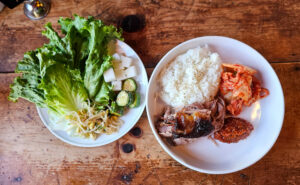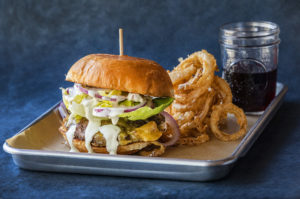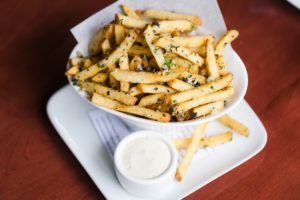Sometimes, it’s fun to see how much we can do, with how little. I could list the underlying moral imperatives – saving money and time would presumably occupy the penthouse suite – but in the main, I just think it’s plain fun, a sort of Sudoku with pots and pans.
Case in point: How do you feed 3 persnickety kids, using just 3 ingredients, in only 30 minutes? Why 3, 3, and 30? 3 kids, because I get my wife pregnant just by looking at her the wrong way; 3 ingredients in 30 minutes, because seemed a plausible benchmark for the real world; and because I’m capricious, and I say so.
You have a Niman Ranch bacon-wrapped pork chop that you bought at Costco for a bit under $7/lb; a half-full bag of heirloom Japanese rice in the cupboard, available at Safeway for around $8/5lb bag; and the Dwarf Navel Orange tree pictured at left, heavy with fruit the color of life jackets. You get 30 minutes to prepare a coherent plate of food for three young children, one of whom subsists on a diet of nothing but colorless carbohydrates, a range of milk fats, and salt. GO.
a half-full bag of heirloom Japanese rice in the cupboard, available at Safeway for around $8/5lb bag; and the Dwarf Navel Orange tree pictured at left, heavy with fruit the color of life jackets. You get 30 minutes to prepare a coherent plate of food for three young children, one of whom subsists on a diet of nothing but colorless carbohydrates, a range of milk fats, and salt. GO.
- T-30. Under the gun, the main thing is triage: What needs to be done now, what can wait, how not to get behind. Generally, this means getting your pans hot – one for the chops, saucepan for the OJ – but if you’re making rice, that better get going, too. Nothing ruins a nice meal of pork chops with rice like no-rice. And turn the oven on.
- T-25. Chops sizzle as they hit the pan, in a little butter, with a sprig of rosemary for aromatics. OJ, sugar and vinegar reducing in the saucepan. Rice not to be disturbed. Very little to do all of a sudden, so time to open the wine and get out the plates. (I’d probably serve this with a Viognier to pair with the lighter meat and the bright, fresh flavors of orange and rice wine vinegar). Once they develop a nice crust, turn the chops over, and stir the OJ mixture, just to feel productive (actually it’s to make sure it all incorporates).
- T-15. Put the pan with the chops in the oven, checking the internal temperature. (You want to eat it close to 160F, so pull it a bit before then, giving it time to rest and continue cooking off the heat.) Check the consistency and seasoning of the sauce.
- T-5. Strain sauce and season and fluff the rice. Just enough time to get it all on the plate and refill that wine glass.
- T-0. Dinner: Pork chops, pan-roasted with rosemary from the garden, on a bed of gaijin-style sushi rice, and a drizzle of this nice home-grown Navel orange gastrique that I’ve pasted in over at the right, and which I wish I would have photographed without a cat toy in the background.

As to the recipe, I know a fair bit about eating sushi rice – done properly, which is to say almost never, sushi meshi requires the hand of an artisan and a delicate balance between temperature, texture, and seasoning – but almost nothing about cooking it, which is why I called mine gaijin style and invariably fall back on someone else’s simple recipe; a pan-roasted pork chop is self-explanatory, although I would emphasize the thermometer (well-done is inedible, and rare is dangerous); and the fresh orange gastrique, although it sounds like fancy footwork, is actually one of the quickest, easiest, and healthiest (a thickly textured, glossy sauce with no fat!) of sauces, and about which I drool ecstatic in this post from late last week. Don’t forget the wine!










